Understanding the Difference Between a Bill of Lading and an Invoice
When it comes to international trade, documents play a vital role in the smooth functioning of the process. Two of the most important documents that come into play are bills of lading and invoices. While these two terms may be used interchangeably, they serve different purposes and contain different information. Understanding the nuances between these two documents is essential to ensuring a seamless business transaction.
What is a Bill of Lading?
A bill of lading is a legal document that serves as proof of shipment of goods from the seller to the buyer. It outlines the details about the goods being shipped, including the quantity, weight, and description. Additionally, it specifies the terms of shipment, including the mode of transport, the shipper and receiver’s names and addresses, and the date and place of delivery.
There are different types of bills of lading, including:
- Straight Bills of Lading: Non-negotiable, specifies that the goods are to be delivered to a specific person or company.
- Order Bills of Lading: Negotiable, can be transferred to another party by endorsement.
- Bearer Bills of Lading: Negotiable, can be transferred by delivery alone, without the need for endorsement.
Furthermore, a bill of lading can also serve as a receipt of goods, as it confirms that the goods have been received by the carrier for shipment. It can also be used as a document of title, giving the holder the right to take possession of the goods upon delivery.
What is an Invoice?
An invoice is a document that accompanies the products or services delivered by the seller to the buyer. It is a request for payment and serves as a record of the transaction. The invoice outlines the details of the goods or services delivered, including the quantity, cost, date of delivery, and payment terms.
Additionally, an invoice may include other important information such as the seller’s contact information, the buyer’s contact information, and any applicable taxes or discounts. It may also include a unique invoice number or reference code to help both the buyer and seller keep track of the transaction.
Why are Bills of Lading and Invoices Important in Trade?
Bills of lading and invoices are critical documents in international trade because they facilitate a secure and straightforward exchange. The bill of lading serves as proof that the seller shipped the goods while the invoice requests payment for those goods. Without these documents, disputes and confusion may arise, leading to delayed payments, damaged relationships, and potential legal issues.
The Purpose of a Bill of Lading
The purpose of a bill of lading is to verify that the goods have been shipped, primarily for international transactions. In addition to serving as proof of shipment, the bill of lading serves as:
- Proof of shipment
- A receipt of shipment
- A title of ownership
- A contract of carriage
Moreover, a bill of lading serves as a document of transfer, allowing the goods to be bought and sold while in transit.
The Purpose of an Invoice
The purpose of an invoice is to request payment for goods or services provided. The invoice outlines the cost of the goods or services provided, including any taxes or fees applicable to the transaction. It also serves as a record of the transaction.
Additionally, an invoice can be used as a tool for managing cash flow by sending out invoices promptly and following up on any outstanding payments.
Legal Differences Between a Bill of Lading and an Invoice
From a legal standpoint, there are significant differences between bills of lading and invoices. The bill of lading represents the goods’ physical movement from one place to another, whereas an invoice represents the business transaction’s financial obligation.
Another significant difference is the timing of their issuance. A bill of lading is typically issued before the goods are shipped, while an invoice is issued after the goods have been delivered.
What Information is Contained in a Bill of Lading?
A bill of lading typically contains essential information about the goods being shipped, including:
- Name and address of the consignor and consignee
- Type and quantity of goods being transported
- Date and place of pickup and delivery
- Carrier’s name and address
- Special shipping instructions
What Information is Contained in an Invoice?
An invoice typically contains information such as:
- Names and addresses of the buyer and seller
- Date and place of the transaction
- Description of the goods or services provided
- Cost of the goods or services
- Any applicable taxes or fees
Types of Bills of Lading
There are several types of bills of lading in international trade, including:
- Negotiable bills of lading
- Straight bills of lading
- Order bills of lading
- Bearer bills of lading
Types of Invoices
There are various types of invoices in use today, including:
- Proforma invoices
- Commercial invoices
- Credit memos
- Debit memos
- Time-based invoices
How to Create a Bill of Lading
Creating a bill of lading involves gathering all the necessary information about the shipment and drafting a document that outlines that information. Several templates and software programs are available to assist with bill of lading creation.
How to Create an Invoice
Creating an invoice involves gathering the necessary information about the goods or services provided and drafting a document that outlines that information. Several templates and software programs are available to assist with invoice creation.
When to Use a Bill of Lading vs. an Invoice
A bill of lading is necessary for any international shipment as proof that the goods have been shipped. In contrast, an invoice is necessary for all business transactions to request payment for goods or services. It is essential to have both documents in place to ensure a seamless business transaction.
Common Mistakes in Using Bills of Lading and Invoices
Some common mistakes that businesses make when using bills of lading and invoices include:
- Not accurately describing the shipment or the goods/services provided
- Using the wrong type of document
- Not including all necessary information
- Not following up on invoices and payments promptly
Avoiding these mistakes can ensure a smooth and successful business transaction.
Best Practices for Using Bills of Lading and Invoices
Some best practices include:
- Ensuring that the shipping information matches the invoice information
- Using appropriate document types
- Including all necessary information
- Maintaining proper records of shipments and payments
- Following up on payments promptly
- Maintaining open communication between buyer and seller
Understanding the Role of Bills of Lading and Invoices in Payment Collection
Both the bill of lading and the invoice play a vital role in payment collection. The bill of lading serves as proof that the goods have been shipped, while the invoice serves as a request for payment. Accepting or rejecting either document can impact payment collection, so it is essential to pay close attention to both documents’ details.
Conclusion
Overall, bills of lading and invoices play critical roles in international trade. While the two terms may be used interchangeably, they serve different purposes and contain different information. It is essential to understand the nuances between the two documents to ensure a smooth and successful business transaction. Using appropriate document types, including all necessary information, and following up on payment collection can ensure a seamless business process.






















